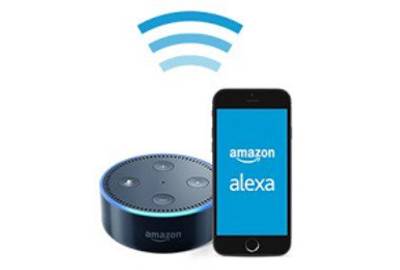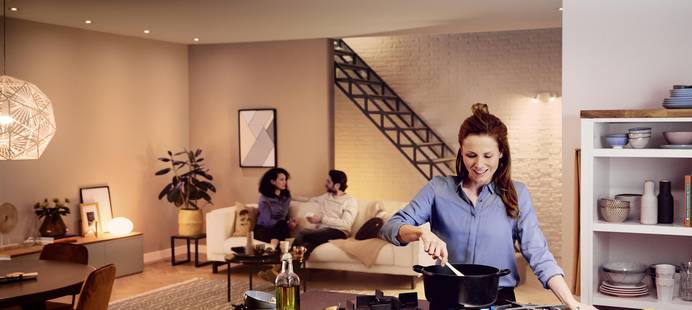Smart home systems & solutions » The most popular devices
Updated: 17.08.2023 | Reading time: 8 minutes
Make your home smarter and more comfortable with smart home technology. Control lights, heating, shutters and other devices easily via smartphone, tablet or voice command. Enjoy more comfort, security and energy efficiency in your home.
But the range of smart home systems is huge. Various systems with different functionalities and price ranges vie for your favor. It's easy to lose track.
To make the right decision, you should first ask yourself: What should my smart home be able to do? What tasks do you want to automate? Do you want to save energy, increase security or simply improve everyday convenience?
In our guide, we explain the various smart home systems and show you how to find the right solution for your needs. You will also receive practical tips on installing and using smart home technology.
Turn your home into a place that adapts to you!
If you are just starting out in the world of smart homes, it makes sense to get an overview before you find out about specific systems.
You can find the answers to the most important questions about components, installation and data protection in our smart home guide for beginners.
There you will also find out which connection solutions are suitable for the structural requirements and find all the options for control and networking at a glance.
There are a variety of different home automation systems.
Some are primarily intended for specific tasks, such as wireless light control via wireless switches, smartphones and tablets.
Others are stand-alone systems for invisible integration into appliances, sockets and control cabinets.
Then there are solutions for greater home comfort that are aimed at a clearly defined area, such as more security within your own four walls, energy-saving heating or remote switching of sockets.
All-round solutions, on the other hand, aim to cover as many areas of smart living as possible.
Because not all systems and products are compatible with each other, all areas of application should be considered before purchasing.
If the focus is on one main task that is particularly important, a smart home system that fulfills precisely this specific requirement is often sufficient. All-round home automation systems take several areas into account.
To help you find a smart home system that meets all your needs in the long term, we offer numerous guides and projects from all areas of smart home application for inspiration.
Smart home project idea: Set up smart changing table lighting
The baby wakes up in the middle of the night and needs a new diaper.
Long walks to the light switch and switching on bright lamps? Unthinkable, after all you want your little one to fall asleep again quickly.
It would be practical if pleasant, subdued lighting on the changing unit could be switched on automatically using a motion sensor.
We offer comprehensive support in selecting the best smart home system for your purposes.
On the page for each smart home system, we provide information about the advantages and disadvantages of the solution in question in our guide.
Networked home automation systems usually work with their own system center (gateway, base station) for connection to the WLAN router and with their own app. Communication between smart home solutions from different manufacturers normally does not take place, or only to a limited extent.
For you as the user, this means that as soon as several systems are to be used in your rooms, such as one for smart lighting control and one for intelligent heat regulation, you will be working with different apps.
Each app is responsible for a different task. For example, if you want to switch on the lights and heating from the car when you arrive home after work, this requires more than one action.
We have explained various options for networking different smart home systems in more detail in our “Smart home software” guide!
More and more devices in the smart home can also be controlled via voice assistants. The digital assistants provide convenient functions and simple operation on demand.
In addition to networked loudspeakers, smart lights, roller shutters, heating or networked kitchen appliances such as coffee machines can be operated using natural language. Just say what you want.
The assistants report the execution of the commands in a natural-sounding voice.
To the digital voice assistants guide »
Amazon Echo and Alexa
Alexa is a cloud-based voice service specially developed by Amazon, which makes it possible to control smart home devices via voice commands, play music or provide weather information, for example.
Although other devices, sometimes even devices from other manufacturers, can also be controlled with Alexa, the voice assistant is primarily designed for the Amazon Echo.
The speaker responds to the human voice and is equipped with voice recognition.
As soon as you say the activation word or press the action button on the top of the device, the Echo is ready to accept questions or commands.
Google Home and Assistant
Google Home is a device that is controlled by voice. The loudspeaker permanently records the sounds of the room in which it is located.
However, it only becomes active when the words “Ok Google” or “Hey Google” are spoken.
Once activated, you can use your voice to send a command to the assistant. This command is sent live to Google servers and processed further. As a result, you receive the answer from the Google Home speaker a perceived second later.
The voice search functionality behind it is the same as the Google Assistant on your smartphone.
Apple HomePod and Siri
The existing voice assistants from Google, Amazon and others are now facing competition from Apple. However, the American company emphasizes that the HomePod is primarily intended to stream songs, audio books or podcasts from Apple Music.
It can also control home automation functions. Siri answers all questions and performs all tasks in the same way as Apple users are used to from their iPhone.
For example, Siri starts music playback, provides information about the weather, manages the calendar or reads out personal messages.
Mowing the lawn and watering the garden with a watering can and hose take up a lot of time. It's a good thing that you can now initiate and operate watering and mowing via smartphone. “Smart gardening” or ‘smart garden’ for short stands for the intelligent control of robotic lawn mowers and irrigation.
The latest generation of networked irrigation systems and robotic lawn mowers maintain wireless contact with an app on your smartphone or tablet.
All relevant settings relating to your garden can be made in the app: Green and plant areas, preferred mowing and watering intervals, separate rules for weekdays and the weekend and so on.
As you drive the car through the gate into the company's parking lot in the morning, the lights at the entrance, in the hallway and in the offices come on - activated by the position data transmitted via the Internet from the smartphone in your pocket.
Smart light helps to control lighting conveniently, efficiently, in an energy-saving and environmentally friendly way.
On-demand lighting increases well-being in the workplace and is easy on the wallet. You can adjust the lighting to the time of day from anywhere in the building at the touch of a finger - even outdoors.
This means that outdoor or shop window lighting only comes on when it gets dark and goes out at a set time. You can also measure energy consumption.
A large proportion of energy consumption is used for heating.
Smart heating and room climate control is the right way to save energy sustainably and benefit from increased heating comfort.
From intelligent radiator controllers for individual rooms to centrally controlled heating in company buildings, business premises or offices on different floors, there are smart solutions for every area.
Radio-controlled and Internet-connected automatic systems take your individual heating requirements into account and react to external influences such as the weather.
What's more, operating the heating has never been so easy!
Burglary protection does not have to be limited to burglar-resistant doors and windows.
Intelligently networked and app-controlled security technology protects your company, deters unwanted visitors and provides rapid assistance in the event of burglary, fire or other dangers.
Whether it's a partial solution such as a smart video door intercom with image transmission to your smartphone or modular electronic all-round surveillance for buildings:
The smart systems complement mechanical building security and adapt flexibly to your needs and working habits.
Whether on the couch in the living room, while cooking in the kitchen or on the balcony: individual music and customized video entertainment is becoming increasingly important in everyday life.
With Smart Home Entertainment, you can enjoy music, films, series highlights, documentaries, Bundesliga broadcasts, console games and audio books in top quality within your own four walls.
The digital media stored on PCs, notebooks and network hard drives are available to stationary and mobile devices, such as networked televisions, cell phones and tablets, via the home network.
Connected small devices for monitoring bodily functions and smart gadgets offer many practical uses in everyday life.
Activity trackers, bathroom scales, sleep sensors and wearables, especially smart wristwatches, provide support for sports, staying healthy and traveling.
These smart helpers use sensors to measure your pulse, blood pressure, blood sugar, weight and how much you move. If you exceed or fall below the selected limits, you will receive a push notification.
The devices transmit measured values and status information to your cell phone, tablet or computer via energy-saving Bluetooth LE (Bluetooth Low Energy).
There, apps evaluate the data, provide a graphical overview and create individual fitness plans.


